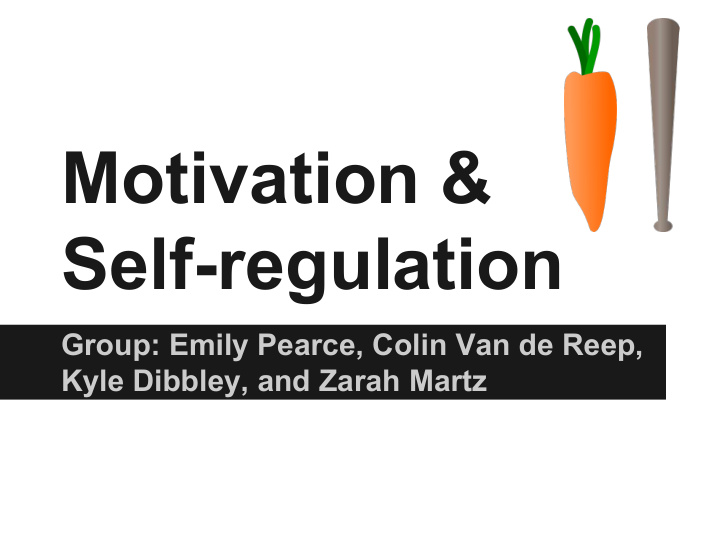



Motivation & Self-regulation Group: Emily Pearce, Colin Van de Reep, Kyle Dibbley, and Zarah Martz
Outline ★ Extrinsic & Intrinsic Motivation ★ Development of Goals and Attribution ★ Bioecology of Motivation & Strategies ★ Self-regulation Photo courtesy of Tamahaji (CC)
Extrinsic and Intrinsic Motivation Drum Roll Please!
Motivation “A state that energizes, directs, and sustains behaviour” (McDevitt & Ormond, 2013, p. 496) Extrinsic Intrinsic Motivation provoked by Motivation resulting from external consequences personal characteristics ● Praise ● Inquisitiveness ● Treats ● High self-efficacy ● Entertainment ● Autonomy ● Grades ● Effective learning strategies ● Punishment ● Long-term interests ● Priorities
Factors Affecting Extrinsic Motivation - Reinforcer - Primary Reinforcer - Secondary Reinforcer - Delay Gratification Courtesy of thievingjoker (Creative Commons License) - Punishment - Vicarious Reinforcement / Punishment
Identify in the Drum Lesson: - Primary Reinforcer - Secondary Reinforcer - Delay Gratification - Punishment Courtesy of photosteve101 (Creative Commons License)
Factors Affecting Intrinsic Motivation - Self-Efficacy - Sense of Self Determination - Situational Interest - Personal Interest - Value Courtesy of photosteve101 (Creative Commons License)
Internalized Motivation External Regulation (Extrinsic Motivation) Introjection (behaving to gain approval, enhance and protect sense of self) Identification (Importance and Value) Integration (integrated into self, system of motive and values, central part of self)
Development of Goals Mastery Goals Aspire to gain new skills and knowledge for self- evaluation Performance Goals Aspire to appear competent as how others may evaluate them Image from Brave (2012) by Walt Disney Pictures
Development of Goals Approach Desire to gain new Focus on achieving knowledge and skills. positive outcomes. i.e. approval & respect Performance Mastery Social Focus on avoiding Perfectionism undesirable outcomes Test anxiety i.e. ridicule & punishment Failure Avoidance
Development of Attributions Attribution: Beliefs about the causes of success or failure Internal vs External Stable vs Unstable Controllable vs Uncontrollable Self-constructed interpretations
Teaching Strategies Mastery & Social Goals Performance Goals ● students value content ● emphasize ● assignments that competition in order encourage learning to get good grades new skills ● when a single failure ● group projects can have dire ● evaluation that allows consequences for for taking risk and final grades making mistakes ● not challenging
Ability Incremental View Entity View Belief: Hard work pays Belief: Either you have off the ability or you do not “I can do it” attitude Learned Helplessness Mastery Orientation
Bioecology of Motivation Motivation can be affected by the student’s gender and cultural background. Courtesy of Epsos.de (Creative Commons License)
Motivation Strategies - Develop and promote Intrinsic Motivation - communicate and develop enthusiasm and curiosity for the topic - create disequilibrium which is naturally uncomfortable and motivates the student to search for equilibrium - give opportunities for physical involvement - offer options/alternatives and emphasize students’ choice - Increase the students’ self-efficacy - give scaffolding and tailored instruction that help them find success - Ensure that rules and instructions allow students to maintain a sense of self-determination
Motivation Strategies - Encourage students to set specific mastery goals - younger children will respond better to short term goals, while older children will be more able to think abstractly about the future and plan long term goals - Help students meet social needs - fear of failure and intense focus on performance are symptoms of a need to feel valued and appreciated by peers. - Tell students specific constructive feedback on the cause of success or failure - put the focus on controllable factors that allow the student to make a difference in their ability to succeed
Motivation Strategies - Teach students about positive attribution - If the student recognizes that hard work and determination lead to success and a lack of such leads to failure, they will be more likely to work hard and be determined because they trust that their efforts will be rewarded. - Downplay failures - Use extrinsic reinforcers when necessary *Always be especially attentive to the needs of students who are academically behind their peers (ex. due to a learning disability or ESL/ELL).
Group Discussion blog.lib.umn.edu Situation You have a student who continually hands in assignments late, and has not responded positively to your offer to provide extra help and work through assignments. This student seems inattentive and unengaged in class, and rarely puts their hand up to answer questions, however when called on directly and guided through the question, the student responds correctly. This student has not been identified as having a learning disability, and is a native english speaker. Discuss which strategies you would use to help motivate this student to improve their performance, and why.
Self-Regulation -Impulse Control -Delaying Gratification -Self-socialization -Emotional regulation -Goal setting -Self-motivation -Self-regulated learning Source : http://bestclipartblog.com
Encouraging Students -Make curriculum relevant -Use the Student’s strengths -Provide support -Communicate Optimism -Give students responsibility -Get involved -Involve students in school policy and management decisions
Promoting Self-Regulation -Having an orderly and predictable environment -Let students make their own choices -Adjust to self-regulatory and vulnerabilities -Support the students’ level of learning -Provide guidance, appropriately -Make suggestions, not commands, when possible -Teach self-regulation skills
Recommend
More recommend